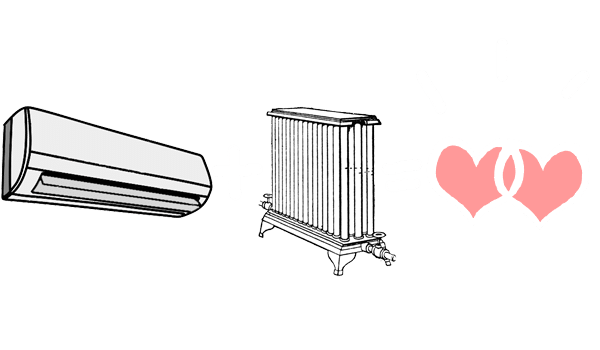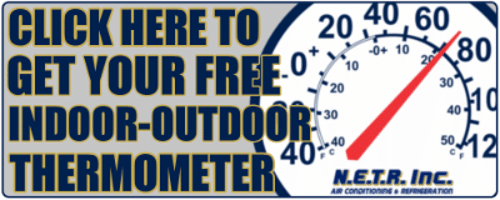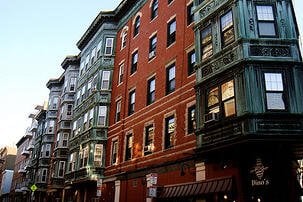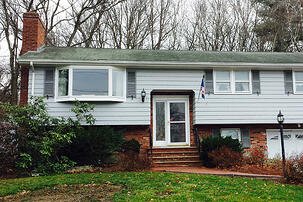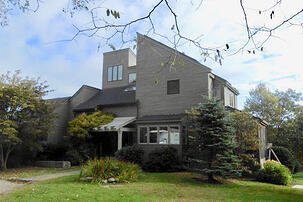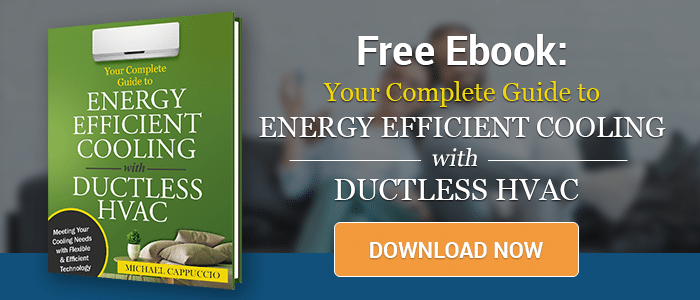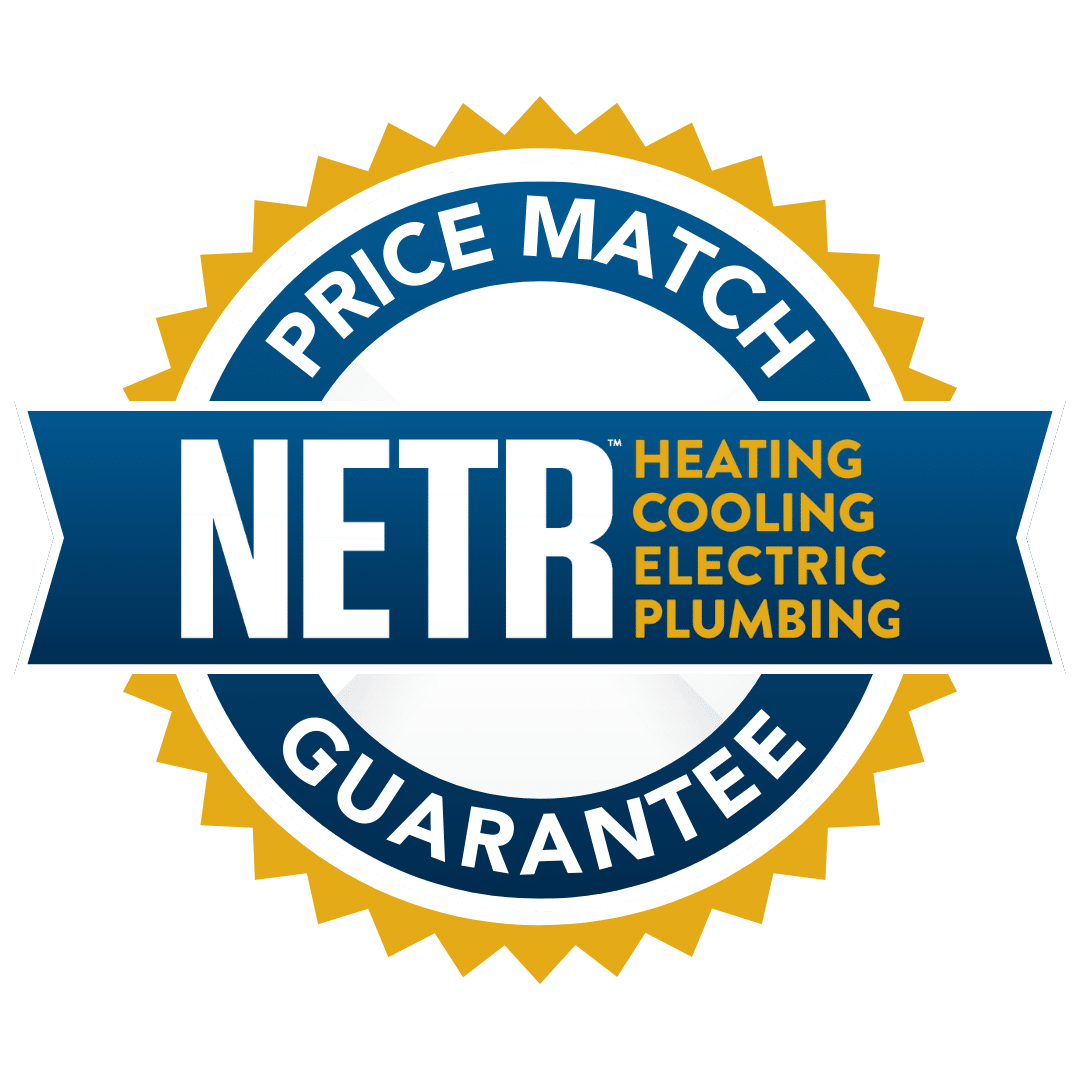Update November 2016: Mass COOL SMART Air Conditioner Rebates to be Reduced

Here is the Latest Update on Mass Save and CEC Rebates – November 2016
Time could be running out on the best rebates we’ve had in a long time.

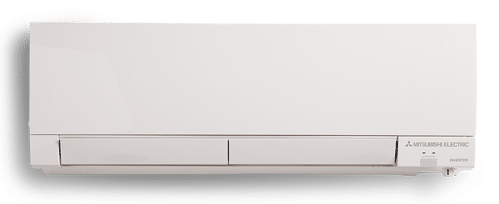
If you think you might even remotely be in the market for a ductless heat pump / air conditioner system before next summer, the clock is ticking. Talk to us now so you can weigh your options. The more zones you need conditioned, the more savings you have at risk.
Rebate amounts were increased earlier this year, and the savings for our customers has been in the hundreds of thousands of dollars. Details are outlined further down. Act soon, as applications for rebates at 2016 levels must be submitted by December 31, 2016 to qualify! Then we’ll have 90 days to complete your installation.
PLEASE ACT NOW!
Ductless is a perfect option for a large family room or open floor plan
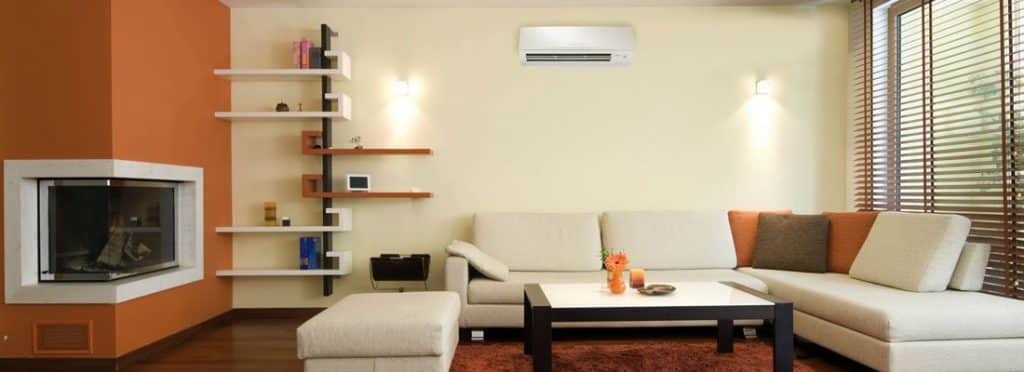
These savings are just the beginning…
Since the rebate amounts were increased earlier this year, we’ve been swamped with installations on the North Shore, in Mission Hill, Beacon Hill, the North End, Cambridge and the Back Bay. Not only will these customers save money on installation, but ductless heating and cooling is up to 40% more efficient than traditional systems which will save them big on energy costs for years to come.

See how these Reading, MA homeowners trimmed their $3000 heating oil bill to $0 in one season, and saved 60% on their overall energy costs.
Click here for the story
We can help you with this process!
We’ve helped hundreds of residents all over the greater Boston area take advantage of this free money to make the transition to super-efficient ductless heating and cooling.
There are a lot of moving pieces to getting the application process correct in order to receive the maximum possible cash back, so please let us help you too.
Check out the unprecedented rebate amounts on the following chart. You could save thousands! When you’re ready, download the application or schedule a conversation with us to get the ball rolling.
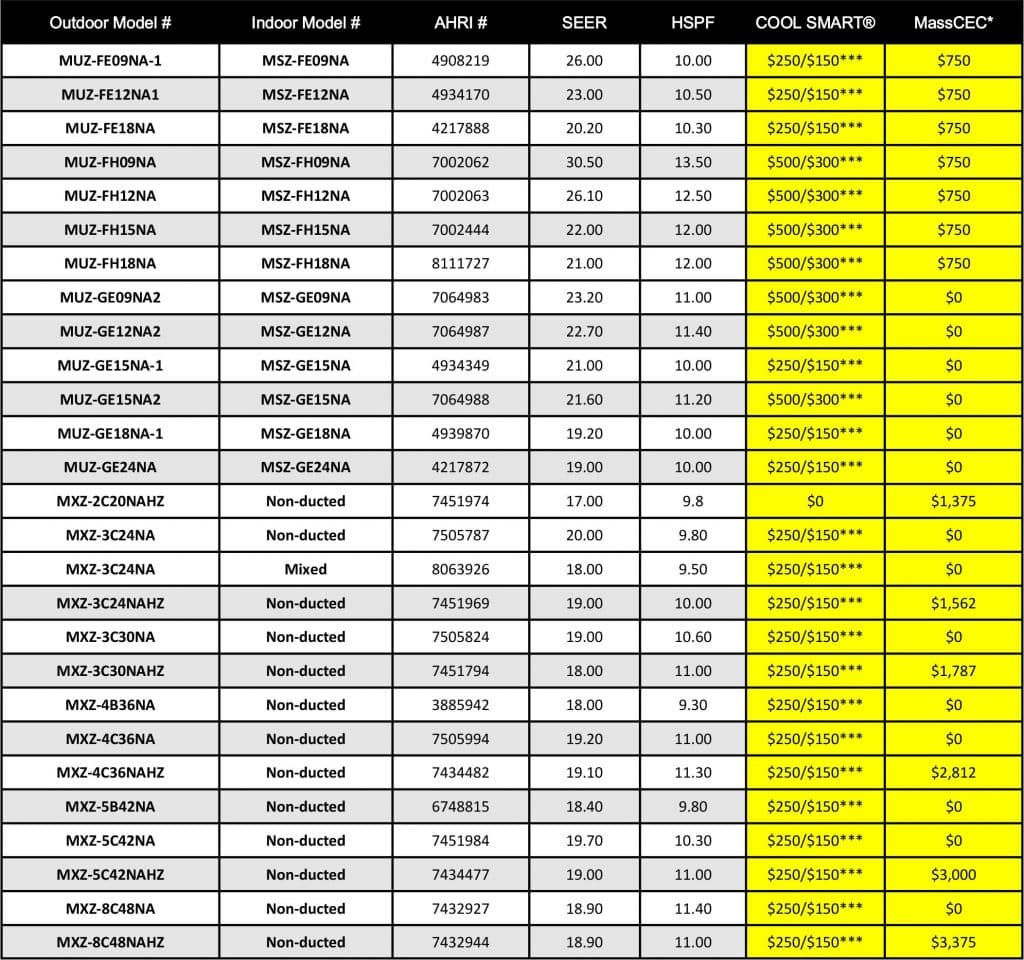

Check out the ductless installation we did in this South End Brownstone.
Read more here

Mass Save Heat Loan Process
Step 1: Call us at 781-933-6387.
Step 2: Our Specialist will explain program at Energy Audit.
What you will need
- Install qualifying product by licensed contractor, like N.E.T.R., Inc.
- AHRI certificate (for AC & Heat Pump rebates only – please keep the original for you records).
- Must be customer of participating utility
- Obtain invoice with model #, size in tons, date and location of installation, and installation cost.
- Within 90 days of installation: Main AHRI cert, rebate application, copy of utility bill, invoice from contractor.
- Copy entire package and keep signed copy.

* MassCEC rebate is available until December 31, 2016.
** Data compiles in June 2016. Programs charge at the discretion of the program manager.
*** Effective 4/20/2015, National Grid of MA rebates are $150 and $300. Mitsubishi Electric is not responsible for actual rebate amounts. Please check with Mass Save* & MassCEC for details and updates.
In order to be eligible for a Mass CEC rebate, Projects must:
- Be installed by a manufacturer-trained installer, like N.E.T.R., Inc.
- Use the installed air-source heat pump (ASHP) for heating consistently throughout the winter.
- Have Eversource, National Grid, Unitil, or an eligible municipal light plant, as the electric provider.
- Include an ASHP from Mass CEC’s list of eligible equipment.
- Have a home energy audit from within the last four (4) years or have one scheduled within six (6) months of project completion. **
To apply for the Mass CEC rebate: Provide the following information to NETR, Inc and we’ll submit the rebate application:
- Project site address and rebate mailing address.
- An initialed and signed Residential Air- Source Heat Pump Participant’s Agreement.
- A copy of a recent month’s electric bill showing the “service for” address and the residential rate code.
- Complete Income-Verification, if applicable.
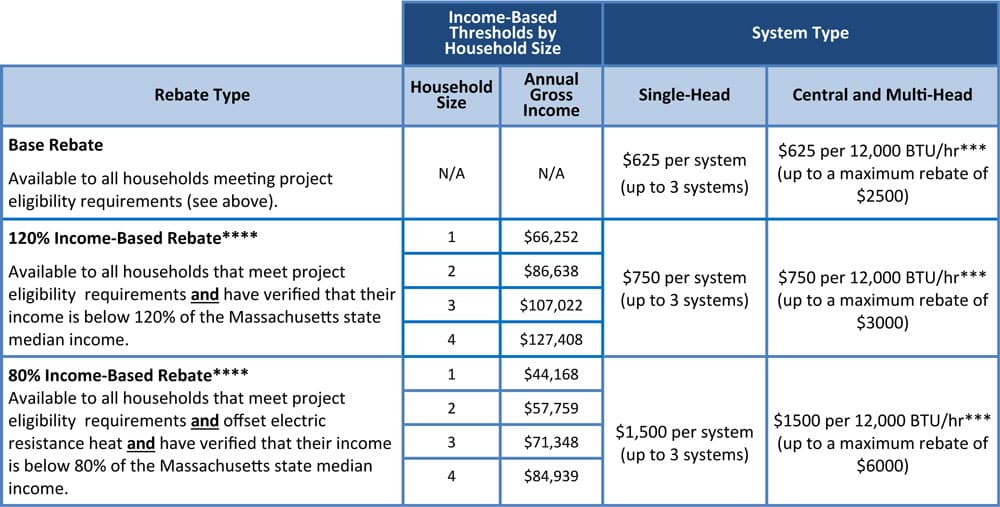
* Full program requirements should be reviewed in the Program Manual.
** New Homes, and multifamily residences with more than 4 units do not require an energy audit. If you live in an area with a scheduling backlog, please submit an email confirming you are in queue for scheduling with your application. Please call us at 781-933-6387 to schedule.
*** For the purposes of determining rebate levels, the Mass CEC uses the system’s maximum heating capacity (BTU/hr) at 5°F.
**** To Receive an Income-Based Rebate, the homeowner must complete one of the accepted income verification methods. Please see the Program Manual (section 2.4) for more information about Income-Based Rebates and income verification methods.
Switching to ductless will save you money

Your energy bills will be lower and you will reduce your carbon footprint.
In addition to the best air conditioning you can possibly put in a home, one of the hidden incentives behind this program, and one of the main reasons they do these huge rebates on ductless systems, is the dramatic energy savings homeowners will see come the winter months.
Mitsubishi’s h2i heat pump inverter technology is a massive shift in heat pump capability and efficiency, especially for New England homeowners who got pummeled by this past winter. These Mitsubishi ductless systems will save you hundreds if not thousands of dollars just by supplementing your gas or oil heating system.
So, folks, take a deep breath and let’s talk about the right system for your home.
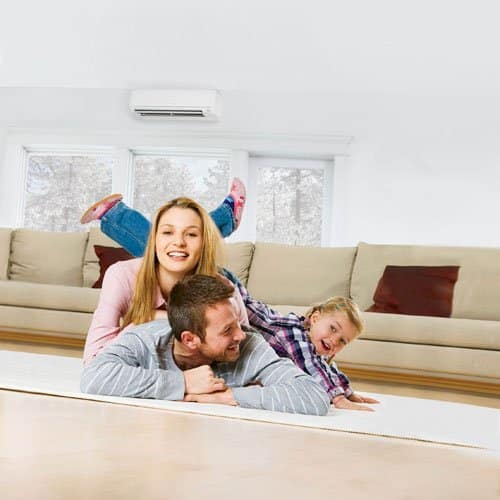
To qualify for rebates at the originally authorized January 2016 levels, equipment must be installed by December 31, 2016, and all rebate forms and required documentation (including dated invoices) must be postmarked or submitted online within 30 days of the equipment installation date.
Submissions not meeting these requirements will be fulfilled at the new rebate levels. Exceptions will be made for customers already authorized for a HEAT Loan based on January 2016 rebate levels.
National Grid is committed to serving as many customers as possible, and will continue to closely monitor the funding for this program in order to serve our customers and save energy.
Window Units vs. Ductless AC
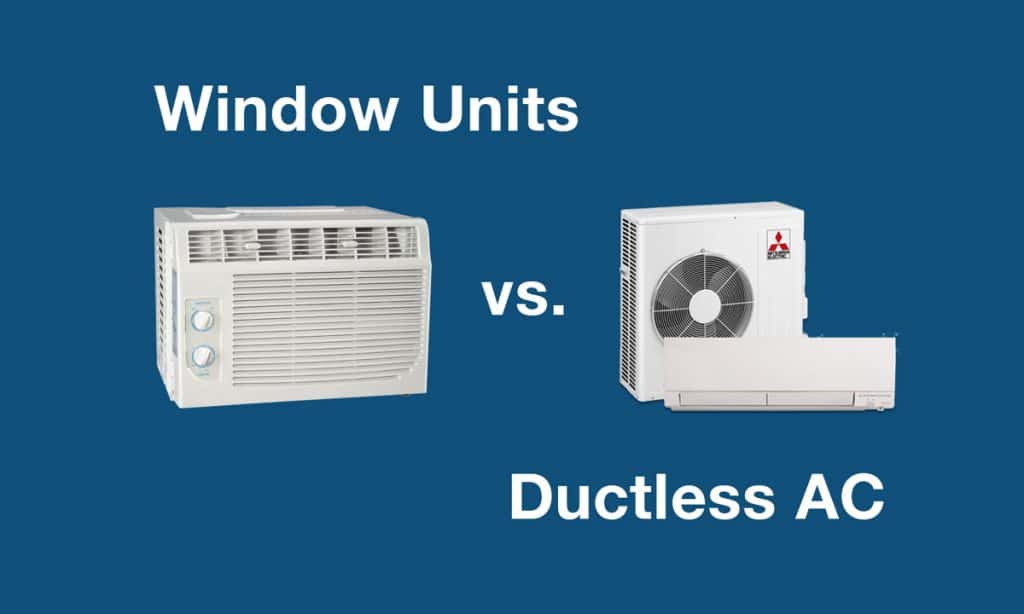
If you’re looking for a new air conditioner, there are a lot of options. If you don’t have ducts and don’t want to add them, you have two main choices: window units and ductless AC. Both can cool at least one room, neither require ducts, but which is the best option?
Here’s a brief guide to the main differences between window units and ductless systems.
What Is a Window Unit?
A window air conditioning unit fits into a window frame or an opening in the wall and it provides cooling for a single room. These units have several temperature and fan settings so you can adjust them according to your needs, and many units let you just use the fan feature without turning on the air conditioning mode. Generally, window AC units have internal thermostats, and they run until they sense that the air in the room has cooled down to the appropriate level.
They are relatively easy to install on your own, but they can be noisy and difficult to control accurately.
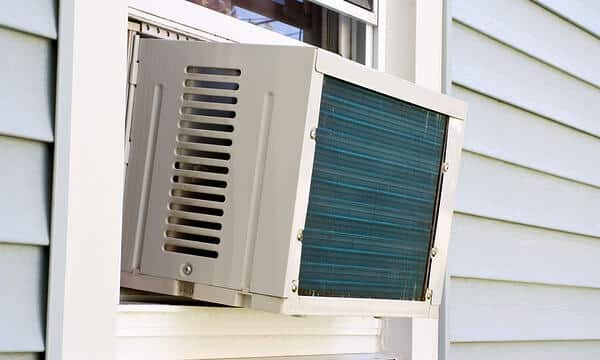
What is a Ductless System?
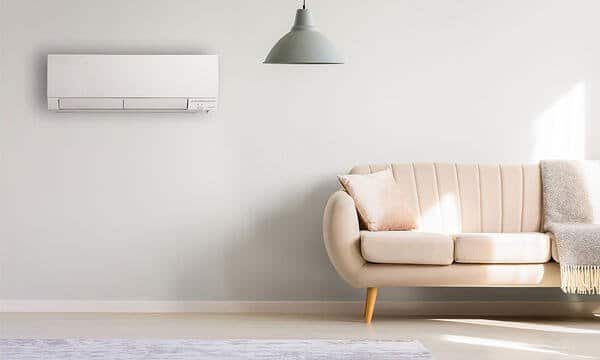
Also called a mini-split, a ductless system consists of both indoor and outdoor components. The outdoor part houses the compressor and the condenser, while the indoor unit handles the cool air. Tubing carries refrigerant, electricity, and communication signals between these two components. Just like all other air conditioners, the refrigerant absorbs heat from inside the building and releases it outside.
Window AC Unit vs. Ductless System
If you are trying to choose between a window air conditioner or a ductless system, here are some of the main factors you should consider:
Security

No matter where you install a window air conditioner, it compromises the security of your home or business. Intruders simply need to hoist the system out of the way to gain entry into the building. With a ductless AC system, the installation contractors only need to drill small holes in your outdoor walls in order to connect the suction lines, refrigerant lines, and power cables. That means that you don’t have to worry about your ductless system creating a security risk in any way.
Convenience

When you install a window air conditioner, you lose the benefits of having a window. You can’t open the window to bring in fresh air, and you may even have to sacrifice a great view. In contrast, ductless systems can be placed nearly anywhere on your interior wall or ceiling. Additionally, window air conditioners are often considered to be temporary cooling solutions. Even people who use them year after year tend to take them down in the winter, and that can be time consuming and annoying. Ductless units are a permanent feature.
Flexibility

Window air conditioners are designed to cool a single room, and to cool multiple spaces or large areas, you need to buy multiple units. In contrast, a ductless system let you pair multiple indoor units with a single outdoor unit, and you can control all of the units separately. To increase your options, the indoor units come in a wide range of different designs, so you can customize your set-up to work with your space. Ductless systems also feature reversible heat pumps and are also capable of providing heat.
Energy Efficiency

When it comes to energy efficiency, ductless systems are clearly the winners. Some window air conditioning units come with ENERGY STAR® ratings, but the SEER ratings on many mini-split systems are much more efficient. In addition, window air conditioners also tend to have a lot of air leaks — gaps between the unit and the window frame are practically unavoidable.
Easy Installation

The absence of ductwork makes ductless systems relatively fast and easy to install. There is no need to tear down walls or do major renovations, and most contractors can handle small installations in a day or so. For large installations with multiple indoor and outdoor units, you can even opt to do the installation in zones so that you don’t have to shut down all of your operations.
Cost

If you don’t have existing ductwork, the cost of ductless is considerably less expensive than putting in a central HVAC system. In cases, where the ductwork is already in place, however, ductless systems may be slightly more expensive than just buying a new central air conditioner.
However, installation is only the first cost to consider. You should also consider energy efficiency, and in most cases, ductless systems are cheaper to run long-term. Beyond that, you never have to worry about cleaning the ducts when you have a ductless system, and that adds to the overall savings.
Mass COOL SMART Air Conditioner Rebates

Here is the Latest Update on Mass Save and CEC Rebates – FEBRUARY 2019
Mass CEC is Ending Energy Efficiency Rebate for Ductless Mini-Splits
Effective March 20, 2019


If you heat your home with oil or propane you have a small window of opportunity to save an additional $2000 with Mass CEC rebates on a multi-zone ductless mini-split system.
This is not a gimmick!
Recent cutbacks to Federal funding and clean energy incentives have dramatically impacted the Mass CEC rebate program, but there is till time to get some of this money.
PLEASE ACT NOW!
We need to have your system installed and your rebate paperwork submitted by March 20, 2019!
THESE REBATES WILL BE REDUCED DRAMATICALLY ON MARCH 20TH!
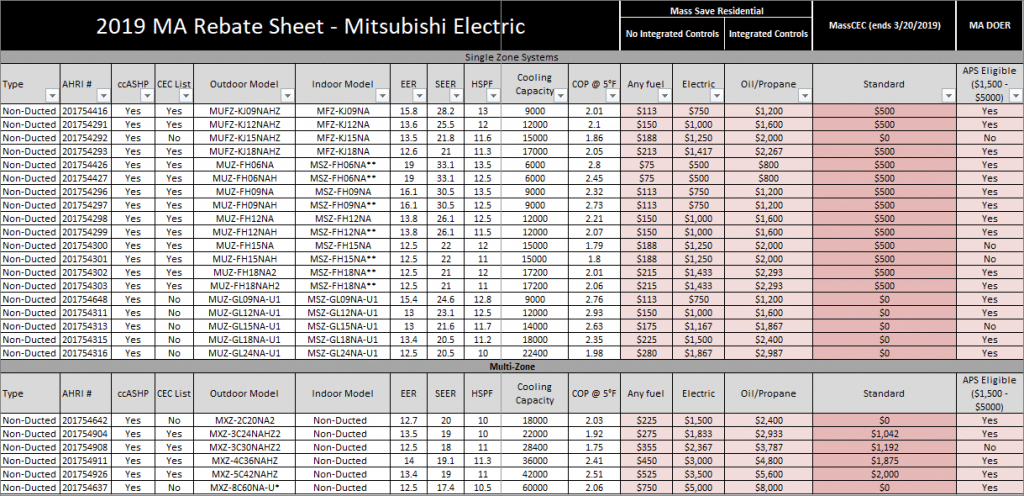
These savings are just the beginning…
Since the rebate amounts were increased, we’ve been swamped with installations on the North and South Shores, Mission Hill, Beacon Hill, the North End, Cambridge and the Back Bay. Not only will these customers save money on installation, but ductless heating and cooling is up to 40% more efficient than traditional systems which will save them big on energy costs for years to come.

See how these Reading, MA homeowners trimmed their $3000 heating oil bill to $0 in one season, and saved 60% on their overall energy costs.
Click here for the story
We can help you with this process!
We’ve helped hundreds of residents all over the greater Boston area take advantage of this free money to make the transition to super-efficient ductless heating and cooling.
Check out the unprecedented rebate amounts on the following chart. You could save thousands! When you’re ready, download the application or schedule a conversation with us to get the ball rolling.


Check out the ductless installation we did in this South End Brownstone.
Read more here

Mass Save Heat Loan Process
Step 1: Call us at 781-933-6387.
Step 2: Our Specialist will explain program at Energy Audit.
What you will need
- Install qualifying product by licensed contractor, like N.E.T.R., Inc.
- AHRI certificate (for AC & Heat Pump rebates only – please keep the original for you records).
- Must be customer of participating utility
- Obtain invoice with model #, size in tons, date and location of installation, and installation cost.
- Within 90 days of installation: Main AHRI cert, rebate application, copy of utility bill, invoice from contractor.
- Copy entire package and keep signed copy.
In order to be eligible for a Mass CEC rebate, Projects must:
- Be installed by a manufacturer-trained installer, like N.E.T.R., Inc.
- Use the installed air-source heat pump (ASHP) for heating consistently throughout the winter.
- Have Eversource, National Grid, Unitil, or an eligible municipal light plant, as the electric provider.
- Include an ASHP from Mass CEC’s list of eligible equipment.
- Have a home energy audit from within the last four (4) years or have one scheduled within six (6) months of project completion. **
To apply for the Mass CEC rebate: Provide the following information to NETR, Inc and we’ll submit the rebate application:
- Project site address and rebate mailing address.
- An initialed and signed Residential Air- Source Heat Pump Participant’s Agreement.
- A copy of a recent month’s electric bill showing the “service for” address and the residential rate code.
- Complete Income-Verification, if applicable.
- * Full program requirements should be reviewed in the Program Manual.
- ** New Homes, and multifamily residences with more than 4 units do not require an energy audit. If you live in an area with a scheduling backlog, please submit an email confirming you are in queue for scheduling with your application. Please call us at 781-933-6387 to schedule.
- *** For the purposes of determining rebate levels, the Mass CEC uses the system’s maximum heating capacity (BTU/hr) at 5°F.
- **** To Receive an Income-Based Rebate, the homeowner must complete one of the accepted income verification methods. Please see the Program Manual (section 2.4) for more information about Income-Based Rebates and income verification methods.
Switching to ductless will save you money

Your energy bills will be lower and you will reduce your carbon footprint.
In addition to the best air conditioning you can possibly put in a home, one of the hidden incentives behind this program, and one of the main reasons they do these huge rebates on ductless systems, is the dramatic energy savings homeowners will see come the winter months.
Mitsubishi’s H2i heat pump inverter technology is a massive shift in heat pump capability and efficiency, especially for New England homeowners who got pummeled by this past winter. These Mitsubishi ductless systems will save you hundreds if not thousands of dollars just by supplementing your gas or oil heating system.
| Additional Resources Mass Save Rebates |

Top Questions To Ask Your HVAC Contractor
From the Desk of
Michael Cappuccio
Good HVAC takes time, effort, and dedication. N.E.T.R., Inc. is focused on providing the highest-quality products and service possible. We care about our customers and work hard every day to ensure they have access to affordable heating and cooling options that are right for them.
I created this eBook because I’ve seen first-hand how difficult it can be to get an HVAC job done right. I want to share with you actionable advice and tips on how to find good HVAC contractors, how to compare apples to apples when it comes to products and services, and how to get more for your money.

Download it now to learn how to make sure your next HVAC job is a successful one.
Sincerely,
Michael Cappuccio
Founder of N.E.T.R., Inc.

Get Your Free Ebook
Read Our eBooks | Top Questions to Ask Your HVAC Contractor
"*" indicates required fields
Why Choose Ductless Air Conditioning In Boston
Mitsubishi Ductless Air Conditioning Offers the Ultimate in Cooling & Heating for Boston, MA homeowners.

Mitsubishi’s ductless air conditioning systems provide Boston homeowners with the most advanced home cooling technology available on the residential market today.
These units enable you to enjoy more precise comfort in one, or multiple rooms – while saving on energy bills.
Unlike traditional ducted systems where one thermostat controls a whole home or large zone, ductless systems give you the flexibility to transform individual spaces into pockets of perfect comfort. So now you can enjoy precise temperatures in sunrooms, workspaces, bedrooms, garages – we even have whole home solutions.
If you’re an empty nester, ductless enables you to control the temperature in individual rooms while closing off the rooms you are not using. This is particularly attractive to people who like their bedroom to be colder or warmer than the rest of the house.
If you are looking for reliable service and support with a system that offers a more advanced technology and more solutions to save energy while improving comfort, then contact N.E.T.R. Inc. today for a free consultation.
Clean Living
The air quality inside your home is often worse than the air quality outside. Ductless Air Systems use a sophisticated multi-part filtration system to remove contaminants such as allergens, viruses and bacteria from air as it circulates within a room.
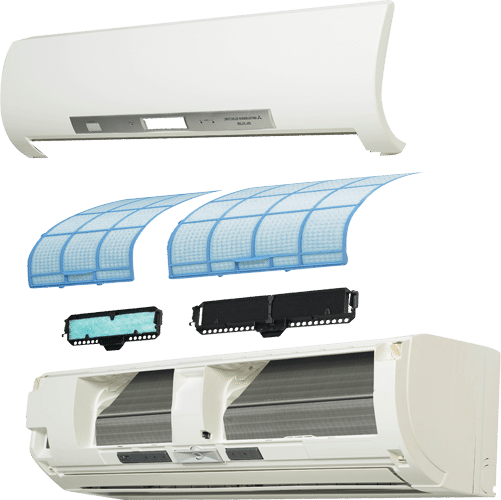
The green technology is friendly to you and the planet. These systems use an environmentally friendly R410A refrigerant which lessens the negative impact on Earth’s ozone layer. Because the ductless systems we install help you reduce your energy consumption, you are doing your part to leave less of a detrimental footprint on the environment.
Energy Efficiency Saves You Money
Ductless Systems are dramatically more efficient than traditional systems. Ductless systems use only the exact amount of energy needed to cool or heat an area by automatically sensing and responding to changes in the area without the unit turning on and off. As a result the cooling unit is up to 40% more efficient than a standard window unit. All this means you reduce your energy consumption and can save money on your energy bill.
If you’re ready to learn more about Mitsubishi ductless heating and air conditioning for your Boston, MA home, click the button below or fill out the form and one of our certified comfort specialists will be in touch shortly.
Contact NETR
CONTROL YOUR AIR CONDITIONING SITUATION ONCE AND FOR ALL!
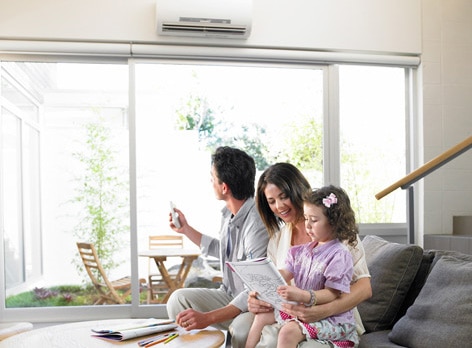
MITSUBISHI DUCTLESS DELIVERS CLEANER AND MORE EFFICIENT COOLING RIGHT WHERE YOU WANT IT
Many Boston area empty-nesters have large homes with traditional central air conditioning systems. With Mitsubishis Electric’s ductless air conditioning, you can control the cooling in the rooms you use every day and close off unused rooms, saving energy and money.
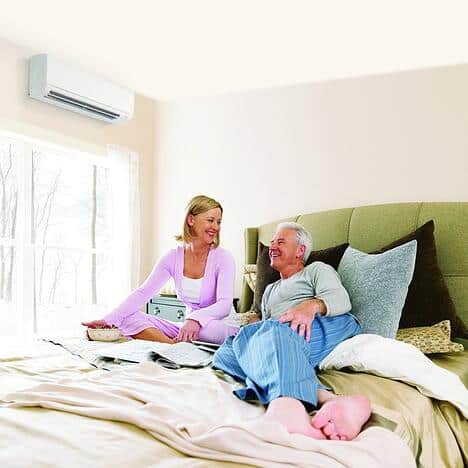
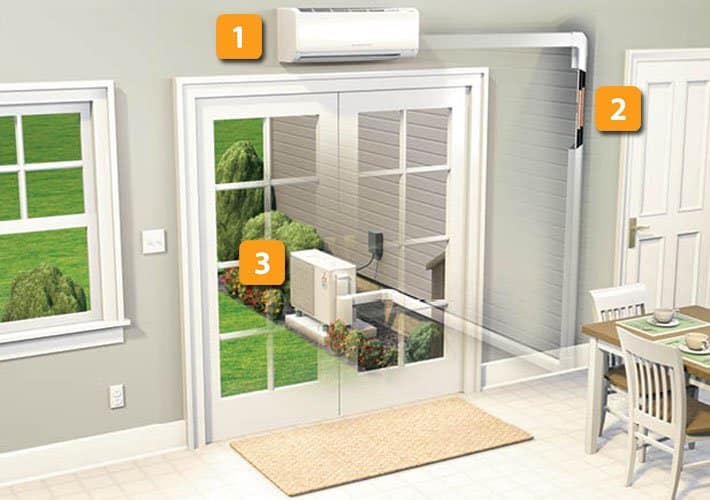
HERE’S HOW DUCTLESS WORKS
Ductless splits, also called “Mini-Splits” pump cooled or heated refrigerant directly to the wall or ceiling-mountedair-handling unit, and each unit has its own wireless electronic temperature control system, a.k.a., a remote.
Here’s how the system works in a single room application in the Boston, Massachusetts area.
1. The indoor unit uses refrigerant to cool or heat air and quietly pushes the chilled air it where you need it in your living space.
2. Refrigerant and electrical lines connect the outdoor unit to the indoor unit through a 3″ opening in the exterior wall.
3. The outdoor unit’s state-of-the-art heat pump cools or warms refrigerant and sends it back inside to the air handler, which continuously monitors the room for changes in temperature and sends conditioned air to the areas of the room that need it.

AIR CONDITIONING FOR THE ROOM THAT IS NEVER COOL
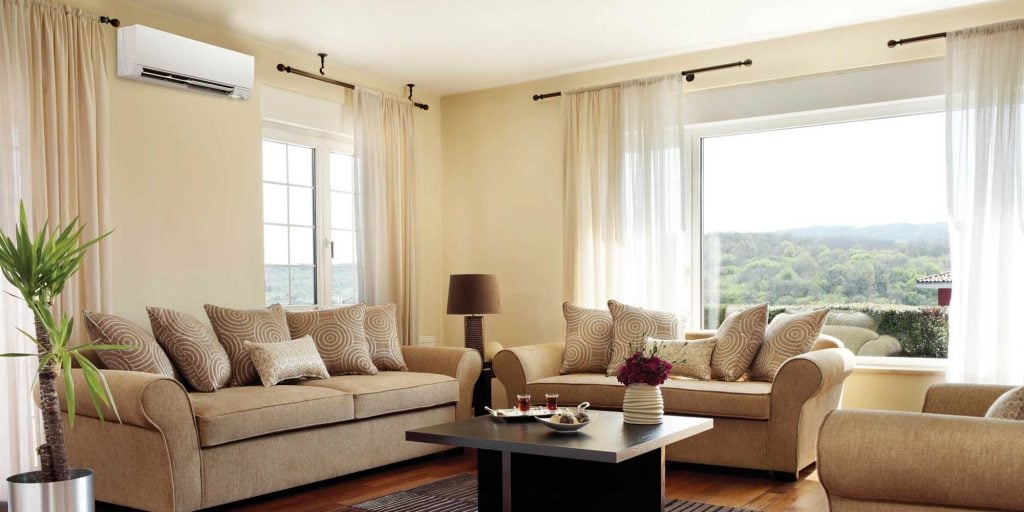
BEAT THE BOSTON HEAT
Boston area residents are accustomed to seeing high temperature and humidity combine to create uncomfortable rooms in every type of construction in every home, condo and apartment.



We’ve installed thousands of Mitsubishi ductless air conditioners all around Boston, and from New Hampshire to The Cape Cod.
Ductless wall air conditioners cut through that opressive wall of heat while operating whisper quiet.

BRING THE SAVINGS
Efficiency is the reason Mitsubishi’s ductless air conditioners have consistently qualified for the highest level of Mass Save and CEC rebates on ductless air conditioners and installation. Combined with 0% payments plans, sometimes these systems can pay for themselves in reduced energy costs in just a couple of seasons. Oh yeah, in winter some models flip to become the most efficent heat pump available to the residential market.
Mitsubishi ductless air conditioning is environmentally and budget friendly.



• Drastically lessen or eliminate your dependence on oil and gas
• Inverter technology results in substantial energy savings
• Zone control for improved comfort and decreased energy use
• Mitsubishi ductless air conditioners are ENERGY STAR® rated
• Local and state utility rebates and incentive opportunities.
Get up to $3750 in incentives & rebates

NETR wants to help modernize your Boston home’s HVAC system. Did you know that ductless mini split systems are also the best way to heat your home? That makes these ultra efficent Mitsubishi systems a whole-house solution that can save you on energy costs year-round. And, for a limited time, NETR is offering up to $400 in incentives and rebates.
Fill out the form on this page to request a no-obligation ductless air conditioningconsultation. We help homeowners like you affordably upgrade their comfort systems every day.
Ductless How to Buy
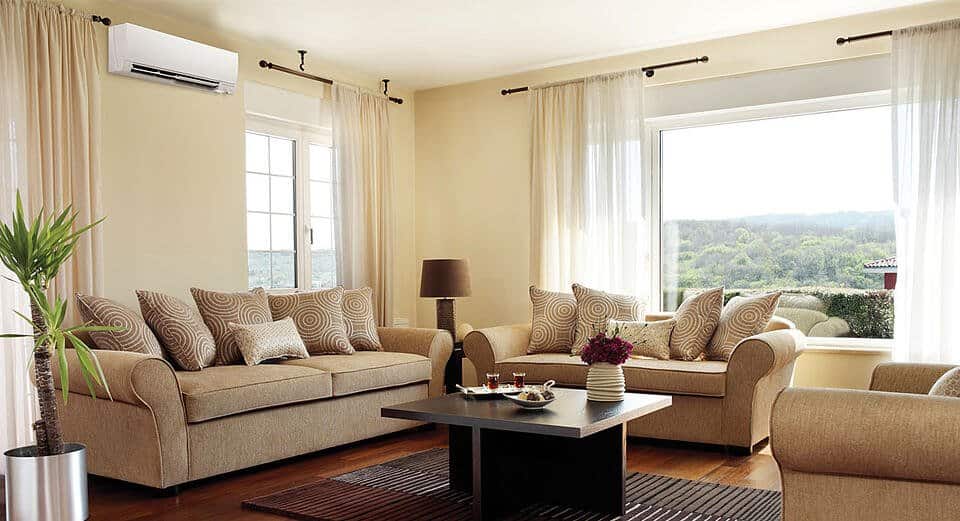
How much does it cost to install a mini split heat pump? Here in the Greater Boston area, ductless heating and cooling in a single zone configuration, fully installed and ready to turn on starts at $8500, and the price goes up from there depending on the number of zones that require conditioning.
More people are choosing Mitsubishi Electric Ductless Mini-Split heat pumps and air conditioners for their home so they can add the comfort they want, right where they need it most. Mitsubishi’s ductless “mini-split” systems combined with WiFi technology and Mitsubishi Electric’s Kumo Cloud system, enable homeowners to manage multiple zones of heating and cooling in the areas of your home where you need it most. And because they are one of the most efficient systems on the market today, you can get the comfort you crave with the flexibility needed to fit your home and your budget.
“…homeowners of a cape-style home in Natick MA decided four zones of comfort would work for them, making each bedroom comfortable and customizable on its own, while putting a separate zone in for the downstairs family room area.”
If you’re like most of our customers, you’re wondering how much it would cost to get the heating and air conditioning you want, while ensuring you keep your monthly energy bills as low as possible.
The cost of zoned systems depends on many factors. The system consists primarily of an outdoor unit connected by refrigerant piping to one or more indoor units, that come in a variety of styles. These indoor units can be networked together to create zones of heating and cooling that can each be controlled separately. A single outdoor unit could create one zone or eight, or anything in between, depending on what you need and what your budget is. Even better, you can expand an existing system to include additional indoor zones in the future, allowing you to stage out costs over time if that’s a concern.
For example, homeowners of a cape-style home in Natick MA decided four zones of comfort would work for them, making each bedroom comfortable and customizable on its own, while putting a separate zone in for the downstairs family room area. You can read more about how NETR helped design the perfect solution for this home by clicking here.
Because of the customization and flexibility of this solution, it’s not as straightforward to give a price as it would be if you were just going to buy a window air conditioner or a whole home, unitary central heating and air system. The solutions offered by Mitsubishi’s Zoned Comfort solutions can be ducted or ductless, or a hybrid of both. This flexibility means the solution for your home, whether it’s a condo in the North End, a split level in Burlington, or a contemporary in Gloucester, can be designed by our experts at NETR, but that the cost will vary depending on the number of zones you need to achieve the comfort you crave. As a Diamond Contractor Mitsubishi, we have the experience and expertise to make sure you get the best and most efficient solution on the market with a full twelve year warranty.
Boston’s North End
Problem: Homeowner needed a new HVAC system and wanted smart phone control and compatibility. Solution: A 4-zone ductless split system with Kumo Cloud controller allowed remote operation from anywhere from a smartphone or computer.
Burlington, MA
Problem: The existing system couldn’t heat and cool the entire home evenly. Solution: We installed a single-zone Mitsubishi Hyper Heat Ductless Unit to supplement existing system, making it easier to maintain an even comfort level throughout the house.
What are the contributing factors that make up the system cost?
The first step to understanding the cost of a new Zoned Comfort Solution for your Boston-area home is to understand the individual elements that contribute to that cost:
A. New equipment. Each Zoned Comfort Solution includes an outdoor unit, indoor unit(s), controls and parts including the refrigerant line-set, wiring and electrical accessories. Conditioning one room or zone comes at a significantly different price than heating and cooling a home with eight or more zones. Generally, new equipment comes in at $8,500 to $30,000. Your costs will vary and may be higher or lower than this estimate.
B. Labor and Equipment. In addition to the cost of the equipment, there is the cost for design and installation of the system, customized for your home and needs. In general, the cost is approximately equal to the cost of the equipment itself, that covers our certified and trained technicians who can handle refrigerants safely, as well as perform the plumbing and electrical work necessary for an installation. Labor costs also vary depending on the complexity of the installation, and this may vary depending on the type of home you own as well.
C. Possible additional costs:
- Electrical. These systems require a 240V outlet, which can cost between $200 to $1,000. The price will increase if your home’s electrical panel requires a new 240V circuit. To avoid surprises, securing an estimate before purchasing a new system is always advised.
- Equipment pad or stand. Creating an even surface underneath the outdoor unit for proper drainage generally costs $50 to $300. Alternatively, units can be mounted on brackets, so be sure to discuss the possible alternatives with us when designing your system and picking the best location for the outdoor unit.
- Ductless or ducted? Choosing ducted indoor units introduces a price that is difficult to generalize. Some homeowners might be installing ductwork for the first time while others may be repurposing some of their existing ductwork, which adds a level of complexity – adding potentially 75 percent to the labor cost. One of the best things about Mitsubishi zoned comfort solutions, especially for older homes and condos, is that they can be installed without ductwork, saving you the time, money and inconvenience of retrofitting a home with ductwork.
- Controllers. There are many controller options to choose from with Zoned Comfort Solutions. What you select will affect the cost. Wall-mounted units come standard with a handheld wireless controller; otherwise, factor in $200 to $300 per controller for a wall mounted thermostat or APP based control for each zone. There are even Kumo Cloud controllers available, which allow you to control your system from your smart phone, a benefit more and more people in the greater Boston area are choosing.
- Any additional equipment needed for unique situations. Some homes need a little extra something; this is true for older homes, high-performance homes, and homes in the mountains or near the water. Some of these homes may require specialized designs and/or equipment, all of which impacts the cost of the system. Mitsuibishi’s Hyper-Heating INVERTER®technology is developed to provide comfortable indoor temperatures even in extreme cold-climate conditions (as low as minus 13 degrees Fahrenheit) while saving energy and money- we’ve got solutions that can work in any of the winter weather Mother Nature can dish out here in New England.
As you can see, there are a lot of variables that affect the estimated cost of a Zoned Comfort Solution. While it is impossible to get a precise estimate of your costs without consulting a local contractor like us here at NETR, there is some third-party data available regarding the low end of the cost range. In July 2016, the Northwest Energy Efficiency Alliance published a study [1] showing that simpler heating and cooling zoned comfort solution installations (defined as having one outdoor unit connected to one indoor unit) range from $3,913 to $4,633. Based on this study as well as internal data from Mitsubishi, and prices increases up to the year 2024, you can expect to pay – on average – between $8,000 and $10,000 for each zone (each area you want to condition). Depending on how you design your system, its total price is likely to fall within a range that averages from $8,000 to $30,000.
Your specific price range is directly impacted by the choices you make with the experts at NETR regarding the number of zones you want to condition, whether to use ductless or ducted indoor units, whether you need cooling only or heating and cooling, if you want a standard or premium product, what type of indoor units work best and so on. As a result, the answer to the question, “How much does a Zoned Comfort Solution cost?” remains a range.
[1] The study was titled, “Northwest Ductless Heat Pump Initiative: Market Progress Evaluation Report #5”; the study can be read in full at http://neea.org/docs/default-source/reports/northwest-ductless-heat-pump…
Depending on your home and your needs, the best way to find out how much a system would cost is to give us a call here at NETR. As a licensed Diamond contractor, we can save you money by designing a system that works for your home and provides the comfort you need for your home- and for your budget.
To get a better idea of what a solution might look like for your home, be sure to check out our case studies of homes across the Boston area. We’ve likely done an installation in your town, or on a home just like yours, and you can get a feel to what the solution looks like and what we helped the owners achieve. Whether you live in a colonial, cape-style, victorian, contemporary, split level, tudor, ranch or a brownstone, we’ve worked on a home like yours and you can see many examples of what might be possible.
Getting an estimate for your home
Give us a call here at NETR. Systems designed and installed by an Elite Diamond Contractor like us are also covered by Mitsubishi’s 12-year parts and compressor limited warranty.
When you meet with us, discuss how many zones you want, where indoor and outdoor units might go, whether you need cooling only or heating and cooling, if you prefer ductless or ducted options (or a mix) and any special considerations – for example if you’re interested in a unit with an i-See™ sensor that detects temperature variations and controls the airflow.We’ll also talk to you about what to expect during the installation process.
Sounds pretty good, right? Soon you’ll have your estimated cost, and after that – a future filled with personalized comfort and energy savings.
How Ductless Works
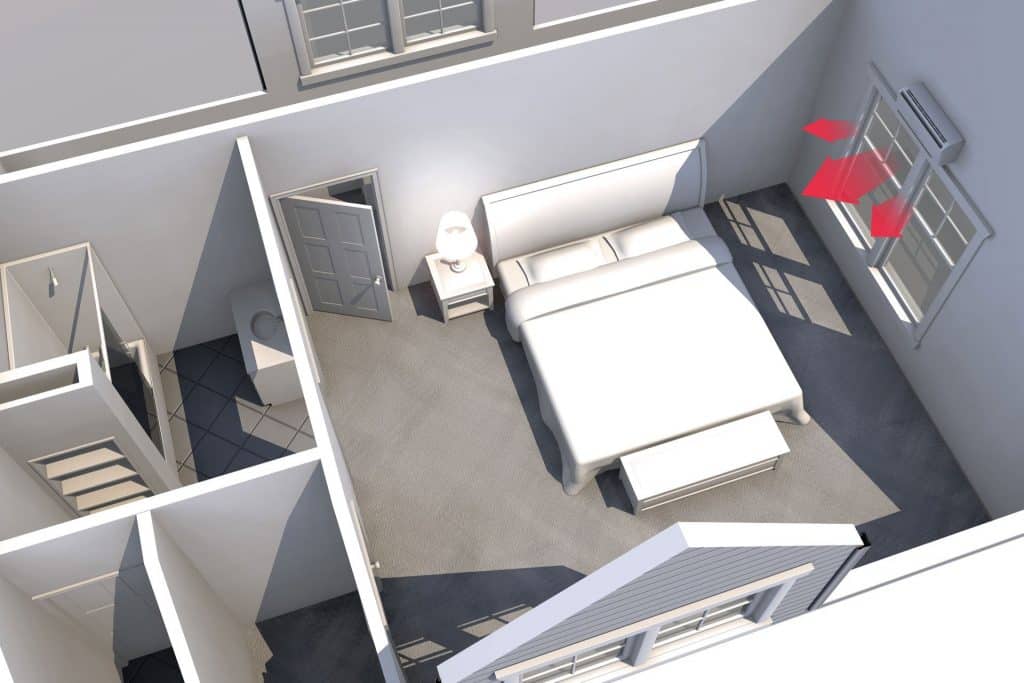
MAXIMIZE YOUR COMFORT
There are many ways to configure this modern and versatile system for all your comfort needs. Highly efficient and effective, a ductless system is the ideal primary heating and cooling solution for your home or business in New England.
See what our customers are saying about us!
HERE’S HOW IT WORKS
Ductless splits, also called “Mini-Splits” pump cooled or heated refrigerant directly to the wall or ceiling-mounted air-handling unit, and each unit has its own wireless electronic temperature control system, a.k.a., a remote.
Here’s how the system works in a single room application:
- The indoor unit uses refrigerant to cool or heat air and quietly pushes the chilled air it where you need it in your living space.
- Refrigerant and electrical lines connect the outdoor unit to the indoor unit through a 3″ opening in the exterior wall.
- The outdoor unit’s state-of-the-art heat pump cools or warms refrigerant and sends it back inside to the air handler, which continuously monitors the room for changes in temperature and sends conditioned air to the areas of the room that need it.
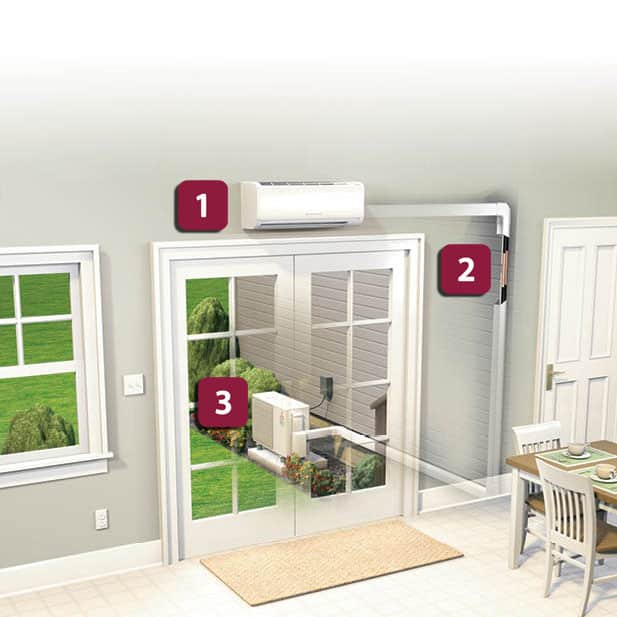
Watch the Video:
YOU CAN HEAT AND COOL A SINGLE ZONE OR MULTIPLE ZONES, BUT WHAT’S THE DIFFERENCE?
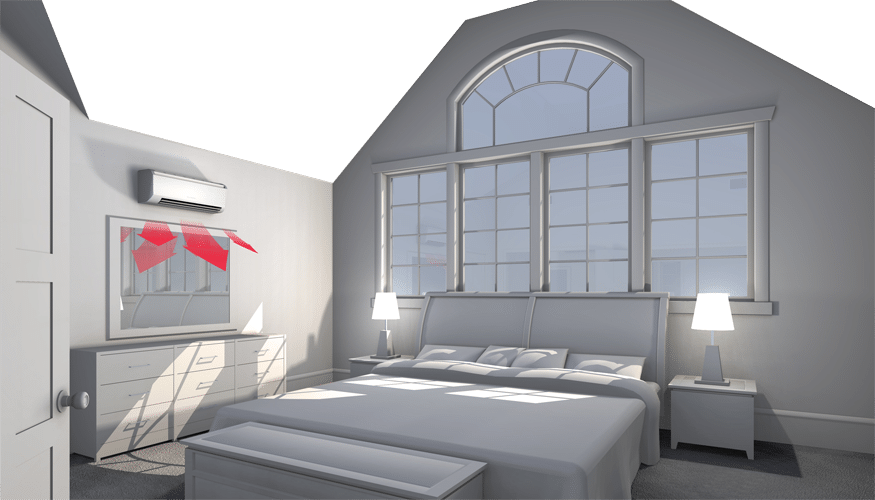
SINGLE ZONE
Perfect for additions, basements, sunrooms or any other space that offers a comfort challenge.
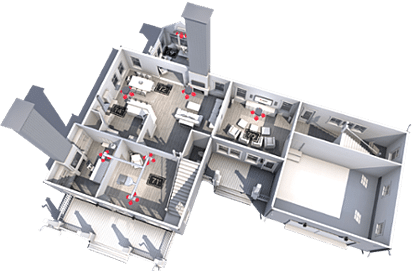
MULTI-ZONE
Keep all the rooms of a house at maximum, individualized comfort levels without all the ductwork.
SINGLE ZONE
Ductless is a perfect solution for homes with problem rooms that just never feel comfortable. You know, a great room with a high ceiling, or large glass exposure. A sun room or addition. Even a converted attic, or a remodeled room over a garage.
Ductless systems allow you to pinpoint the area of your home you want to condition, which always takes some of the load off your existing HVAC system, saving you money.
Check out the video to find out more about how Mitsubishi ductless is such a great solution for single zone applications or click the button below to download a brochure.
Multi-Zone
With a ductless system it’s easy to choose exactly how much you want to heat or cool each room or zone of your home to accommodate your family’s preferences and lifestyle.
Does dad like it cool and mom like it warmer? Kids off to school and spending most of your time in two or three rooms?
With a ductless solution from N.E.T.R. Inc., you can eliminate energy use in the rooms you’re not using, or design a climate in your home based on the factors that make you and your home unique.
MITSUBISHI DUCTLESS SYSTEMS ARE UP TO 40% MORE EFFICIENT THAN TRADITIONAL SYSTEMS
ENERGY EFFICIENT COOLING & HEATING SYSTEMS
Mitsubishi ductless split systems are ENERGY STAR® qualified, and several models are occasionally eligible for federal and state tax credits on top of local utility rebates. This is ever-changing, and can be super complicated, so let us help you navigate this process to ensure you get all the free money you deserve.
Energy providers have significant rebates available for qualifying heat pumps because these systems are so darn energy efficient! In fact, not only will you save on the cost of installation, but between rebates and 0% payment options, you might actually lower your monthly cost of home comfort!
We help Boston area homeowners with these programs every day, and we can help you too.
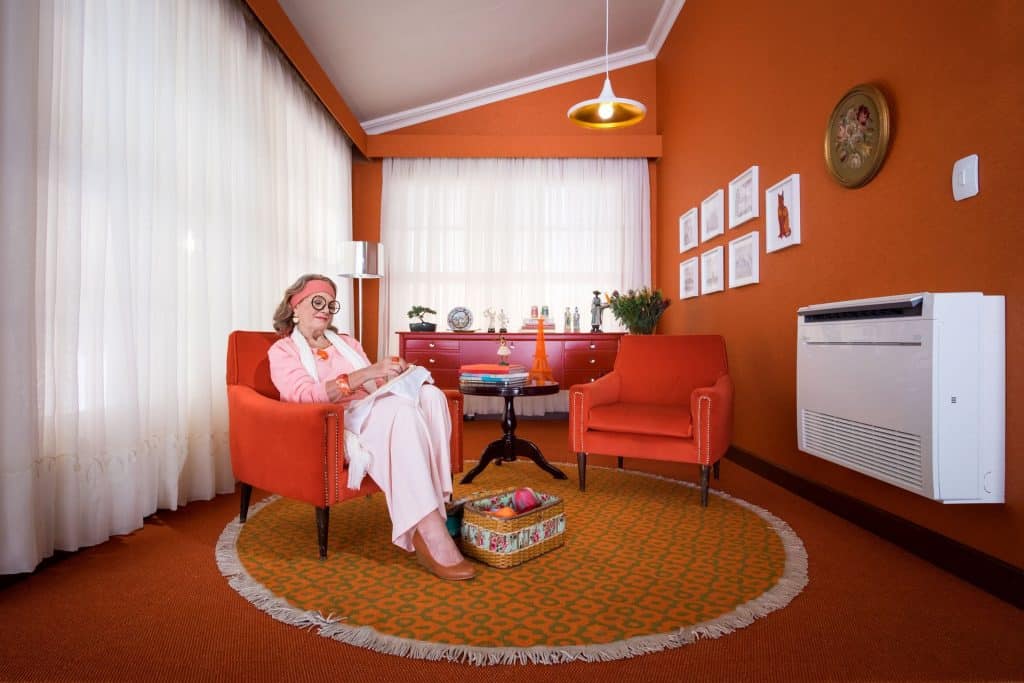
THE BEST HEATING AND AIR CONDITIONING FOR RESIDENTIAL AND COMMERCIAL APPLICATIONS

Find out how Mitsubishi ductless can transform your living space.

Learn how ductless can keep any commercial space comfortable.
All About Ductless
Efficient Technology
The tried and true, “smart technology” behind the Ductless Cooling & Heating systems of today has evolved over time. The technology allows energy efficient, individual comfort control with minimal impact on your home as we offer both ductless and limited length ducted solutions.
The technology behind Ductless Cooling & Heating systems is referred to in many different ways, including mini-split, multi-split, split-ductless, split-zoning, and variable refrigerant flow. Split-zoning technology is the primary method for conditioning spaces in homes and commercial buildings around the world.
Split-zoning systems allow each room (or space), using an individual indoor air-handler, to be controlled independently from other rooms, thus providing individualized comfort control within each room of a home.
A Ductless System uses advanced technology to bring you the ultimate in comfort and control while minimizing energy consumption. A Ductless System uses two small refrigerant lines plus power and control wiring to connect an outdoor unit to each individual air handler. This allows for easy installation in new construction and causes minimal disruption if you are renovating or retrofitting your home.
What is a Mr. Slim? How Does It work?
Mr. Slim is a split-ductless air-conditioning system. If you are familiar with a central system, you have the basic idea of what a split system is: an outdoor condensing unit and an indoor evaporator unit.
The basic difference between the two is that with the central system the evaporator unit is typically found in the attic and has ductwork branched off to the different rooms in your house. With Mr. Slim the evaporator is actually in the room being air-conditioned. The indoor unit has a quiet fan that blows across a cold aluminum coil while in the air-conditioning mode. The indoor unit is usually a wall-mounted type, and this unit is connected directly to the outdoor unit by copper tubing and control and power wiring. In the outdoor unit a compressor cycles refrigerant to and from the indoor and outdoor units, and the room air is cooled or heated based on the direction the refrigerant flows between the two.
Detailed Explanation:
Mr. Slim employs the same mechanical components as any basic air-conditioning system whose interactions cause the process of evaporation to occur. Mr. Slim is a split-ductless design, which simply means the indoor unit is separated from the outdoor unit and is connected by a gas and a liquid refrigerant line. The outdoor unit is considered the hot-side during the air-conditioning process. The cold-side unit is located indoors. In the heating process the compressor reverses this operation, and the heat energy is evaporated in the outdoor unit. Then the indoor unit collects this heat energy while a fan blows air over the indoor coil and distributes the warm air into the room.
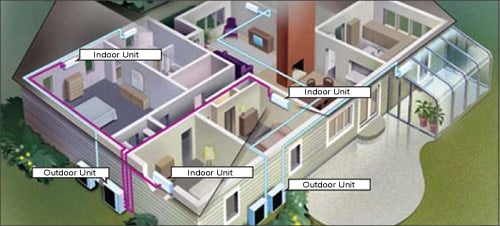
Air-conditioning Basics:
The process of air-conditioning is dictated by simple physics. Through the evaporation process heat is absorbed by the aluminum fan coil in the indoor evaporator unit and is removed from the room by the gaseous refrigerant. The heated refrigerant (pressured by the compressor) flows into the outdoor unit’s aluminum coils. Here a large fan blows across this coil to discharge the heat energy. The liquid refrigerant is cooled by this process and is cycled back to the indoor unit where a fan blows across it and distributes the cool air into the room.
Mr. Slim Filters & Cleans Your Air:
Mr. Slim is designed to circulate air within the space using about the same power as a 40-watt light bulb. Plus there are two standard built-in filters that clean the air and trap virus and toxins while also deodorizing.
- Anti-allergy enzyme filter which uses artificial blue enzyme catalyst on the filter filaments to capture harmful microbes
- Hybrid Catechin Pre-filter fibers infused with a bioflavinoid found in green tea that has antiviral and antioxidant properties
Mr. Slim Takes Care of Humidity:
Mr. Slim’s normal operation takes care of moisture very nicely. The indoor unit’s coil draws the moisture out of the air and wrings it out in the form of condensation that is drained outside or to a near-by drain. Mr. Slim is rated to remove between two to five pints per hour when the return air temperature is at 80 deg.F dry bulb or 67 deg.F, and the indoor relative humidity is around 50%. The outdoor conditions become wetter and can affect the indoor conditions. This will cause Mr. Slim to remove moisture out of the air at a faster rate.
Mr. Slim even has a mode of operation called DRY mode. This dehumidification feature provides added moisture control without lowering the temperature of the room. In this mode the fan speed slows slightly so that the air can spend more time on the indoor coil therefore wringing out more moisture.
Glossary Of Terms
AIR CONDITIONER: A mechanical device used to control temperature, humidity, cleanliness, and movement of air in a confined space.
Btu/h (British Thermal Units per Hour): A term that is used to measure cooling or heating capacity.
CAPACITY or LOAD: A refrigeration rating system usually measured in Btu/h.
COMPRESSOR: A pump found in a refrigeration or air-conditioning system, which pumps refrigerant through pipes between an outdoor and an indoor unit using pressure.
HEAT PUMP: An air-conditioning system that is capable of reversing the direction of refrigerant flow to provide either cooling or heating to the indoor space.
HSPF (Heating Season Performance Factor): A rating of the seasonal efficiency of a heat pump unit when operating in the heating mode.
HVAC: A term which stands for Heating, Ventilation, and Air Conditioning.
INDOOR UNIT: The air-handler of an air-conditioning system, which contains a heat exchange coil, filters, and fan and provides conditioned air into the space.
INVERTER TECHNOLOGY: Mitsubishi Electric’s MSY, MSZ and MXZ and all P-Series outdoor units use INVERTER-driven compressor technology(Variable Frequency Drive)to provide exceptional indoor, high-speed cooling and heating. By responding to indoor and outdoor temperature changes, these systems reduce power consumption by varying the compressor speed for extra energy savings.
MICROPROCESSOR: An electrical component consisting of integrated circuits, which may accept, store, control, and output information.
OUTDOOR UNIT: A component of an air-conditioning system which contains compressor, propeller fan, circuit board, and heat exchange coil. It pumps refrigerant to/from indoor unit.
REFRIGERANT: A gas/liquid substance used to provide cooling by direct absorption of heat.
REFRIGERANT LINES: Copper tubing through which refrigerant flows to and from indoor and outdoor units.
SEER (Seasonal Energy Efficiency Ratio): A rating of the seasonal efficiency of air-conditioning or heating units in cooling mode.
SPLIT-DUCTLESS SYSTEM: A system comprised of a remote outdoor condensing unit connected by refrigerant pipes to a matching, non-ducted indoor air-handler, and a remote controller. Special cases for introducing fresh air may call for limited ducting to air-handler from outside.
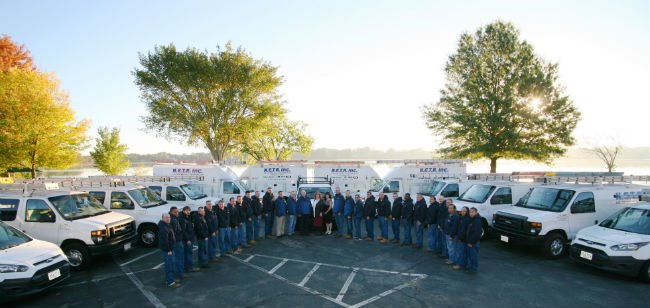
Contact NETR
Ductless for Older Homes
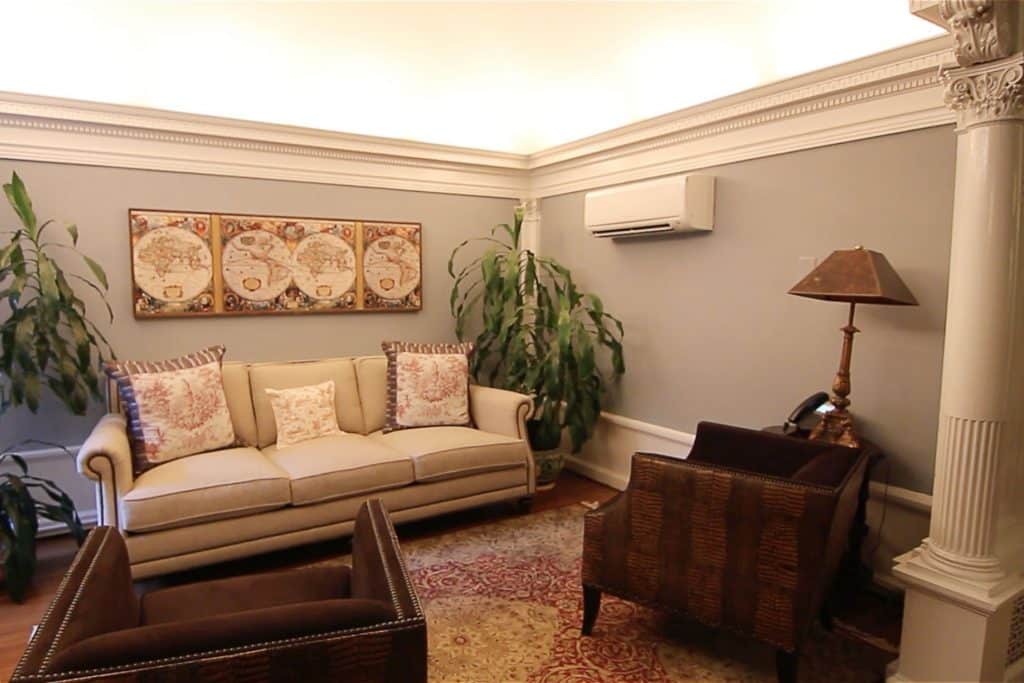
MODERNIZE YOUR COMFORT, KEEP THAT HISTORIC CHARM
When it comes to updating the HVAC system of an older home or structure, ductless is an affordable, non-invasive, energy saving choice.
See what our customers are saying about us!
DUCT-LESS IS MORE
NO DUCTWORK, NO PROBLEM
Often built before central heating and air conditioning were widely available, many older homes have no ductwork at all. To retrofit ductwork in an existing home requires taking away from space to make way for the ducts. Ceilings would be lowered or space would have to be carved out of the rooms. Unlike ducted systems, the footprint of a ductless system is very small.
HISTORIC ARCHITECTURE, INTACT
For many homeowners, part of the appeal of an older home is the architectural charm of older structures. A ductless solution will modernize the home while keeping the architectural integrity intact. The National Park Service (NPS) and Secretary of the Interior Standards and Guidelines for Rehabilitating Historic Buildings have recognized ductless systems for their ability to help maintain this historic character.
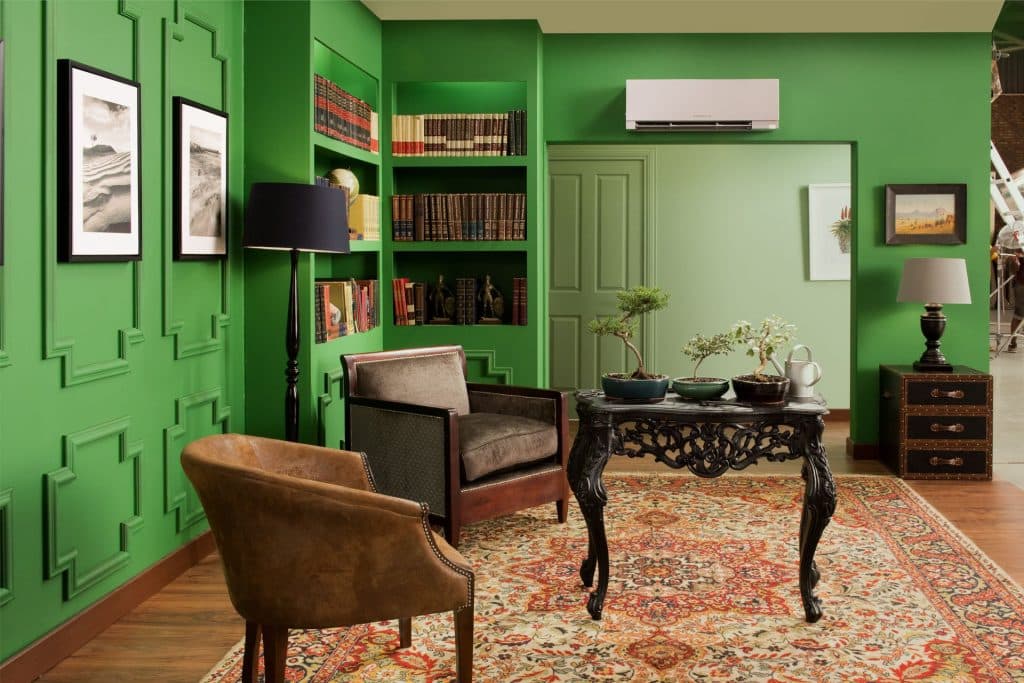
MITSUBISHI DUCTLESS IS FLEXIBLE ENOUGH TO WORK WITH OLDER SYSTEMS
